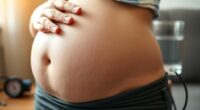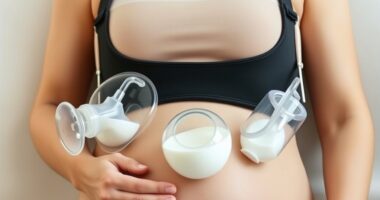When choosing a crib mattress, prioritize safety for your baby. Look for a firm, flat surface that meets CPSC safety standards and fits snugly in the crib to prevent gaps. Opt for breathable materials to reduce the risk of overheating, and select mattresses free from harmful chemicals. Regular maintenance is key to ensuring a safe sleep environment. Want to know the best features and practices for crib mattress safety? There’s more to explore!
Key Takeaways
- Choose a firm, flat crib mattress to support healthy development and reduce the risk of SIDS.
- Ensure the mattress fits snugly in the crib to prevent dangerous gaps for entrapment.
- Opt for GREENGUARD Gold or EWG Verified mattresses to avoid harmful chemicals and ensure low emissions.
- Maintain a breathable sleep environment to enhance airflow and minimize overheating risks.
- Follow safe sleep practices by placing the baby on their back and keeping the sleep area free of soft objects.
Understanding Crib Mattress Safety Standards
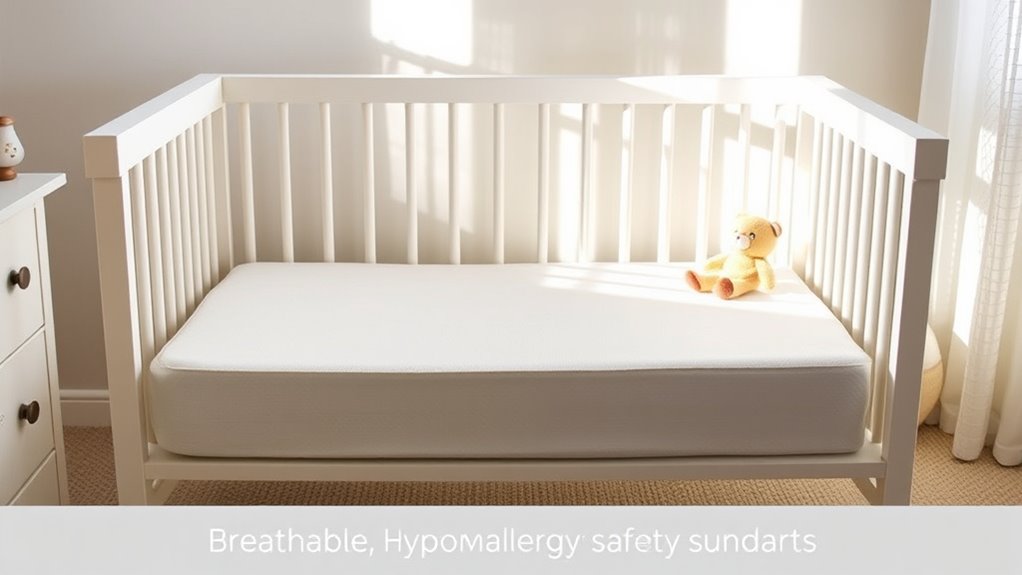
When it comes to choosing a crib mattress, understanding safety standards is vital for your baby’s well-being. Crib mattresses must meet CPSC safety standards, guaranteeing a firm, flat surface that reduces the risk of suffocation and supports your infant’s development. Additionally, using essential oils in the nursery can complement a safe sleep environment by promoting relaxation and improving sleep quality for both baby and parent. Essential oils provide natural antibacterial properties that can help maintain a clean sleeping space.
Look for safety certifications like GREENGUARD Gold, which indicate low chemical emissions and compliance with strict criteria. It’s important to avoid harmful chemicals like PVC and polyurethane foam, as these materials can release volatile organic compounds (VOCs) that may affect your baby’s health. Additionally, verify the mattress has passed ASTM standards for firmness, providing the necessary support for your little one. Regular maintenance, such as cleaning the cover and disinfecting surfaces, helps create a safe, hypoallergenic sleep environment.
Choosing a mattress with low chemical emissions ensures a healthier sleep environment for your baby.
Importance of Firmness and Fit
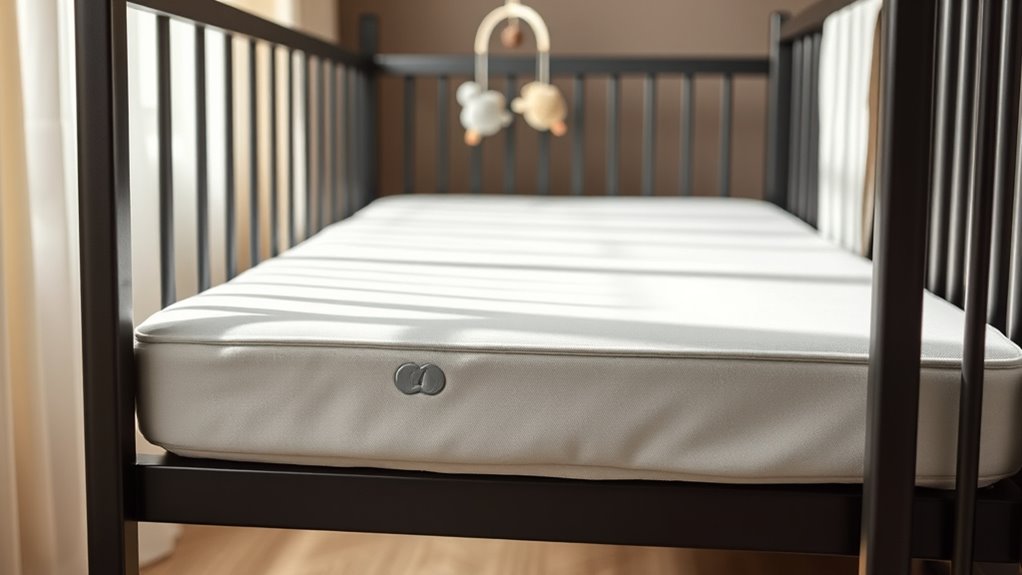
When it comes to your baby’s sleep environment, firmness and fit are non-negotiable.
A firm mattress not only supports healthy development but also aligns with safe sleep recommendations to lower the risk of SIDS. Additionally, choosing a safe sleep environment is crucial for reducing risks associated with unsafe sleeping practices. It is important to understand that emotional support can play a role in your baby’s ability to relax and fall asleep peacefully.
Plus, ensuring the mattress fits snugly in the crib prevents any dangerous gaps where your little one could get trapped. Furthermore, emotional regulation is essential in creating a peaceful sleep environment, as it can influence your baby’s overall well-being and development.
Essential Support for Infants
A firm crib mattress is essential for your infant’s safety and development, as it provides the necessary support for their growing bodies. Firmness is vital because a softer mattress can increase the risk of Sudden Infant Death Syndrome (SIDS) by compromising your baby’s ability to breathe if they roll onto their stomach. The American Academy of Pediatrics (AAP) recommends a firm, flat surface for safe sleep, ensuring no indentations when your baby lies down. Additionally, a crib mattress should fit snugly in the crib, leaving no gaps around the edges to prevent your infant from getting trapped. A standard thickness of about 5 inches is ideal, promoting proper airflow while ensuring the necessary support for your little one. Furthermore, choosing a mattress made from non-toxic materials ensures a safe sleeping environment for your baby. Regularly checking for health concerns related to sleep products can provide added peace of mind for parents. Ensuring that the mattress is made from safe materials can further enhance your infant’s sleeping conditions.
Safe Sleep Recommendations
Firmness and proper fit of a crib mattress play an essential role in ensuring a safe sleep environment for your infant. A firm, flat mattress is critical to prevent suffocation and reduce the risk of SIDS.
It’s important to choose a mattress that fits snugly in the crib, as gaps can lead to entrapment or suffocation. The American Academy of Pediatrics (AAP) emphasizes that sleep surfaces must have no indentations when your baby lies down.
Additionally, use only fitted sheets designed for your specific mattress size to keep the sleep area secure. By prioritizing firmness and fit, you greatly enhance your baby’s safety and create a comfortable space for restful sleep. Furthermore, establishing a budget for baby essentials can help parents choose high-quality sleep products without overspending.
Proper Crib Mattress Size
Choosing the right crib mattress size is essential for your baby’s safety and comfort, as a snug fit minimizes the risk of entrapment. A proper crib mattress should leave no gaps larger than two fingers. Firmness is vital; a firm mattress supports your infant’s developing musculoskeletal system and reduces the risk of suffocation. The American Academy of Pediatrics (AAP) recommends a flat, firm sleep surface, while ensuring the mattress dimensions meet the crib model.
| Mattress Type | Ideal Dimensions | Recommended Thickness |
|---|---|---|
| Standard Crib | 51 x 27.25 inches | 5 to 6 inches |
| Mini Crib | 38 x 24 inches | 3 to 5 inches |
| Portable Crib | 40 x 28 inches | 4 to 6 inches |
Features to Look for in a Crib Mattress
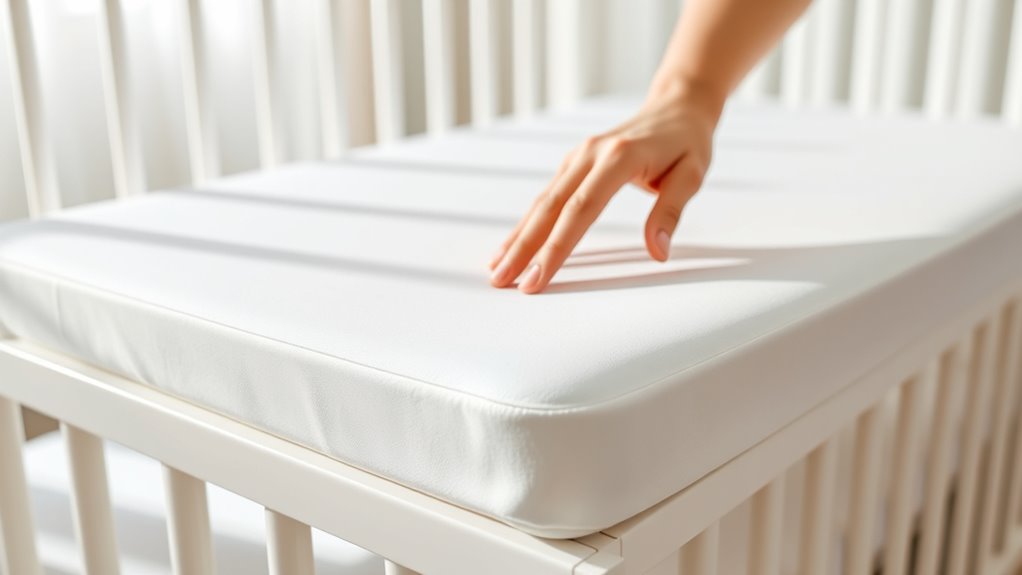
When choosing a crib mattress, look for safety certifications like GREENGUARD Gold to guarantee it meets health standards.
You’ll also want features that promote breathability and temperature control to keep your baby comfortable.
Finally, consider how easy the mattress is to clean, as this can make a big difference in maintenance.
Safety Certifications and Standards
Guaranteeing your baby’s safety starts with selecting a crib mattress that meets essential certifications and standards.
Look for mattresses that are GREENGUARD Gold Certified, which guarantees low chemical emissions and safety for infants. It’s vital to choose options that comply with ASTM and CPSC safety standards, confirming they’ve been rigorously tested for safety and durability.
EWG Verified mattresses are also a smart choice, as they provide transparency about materials and confirm the absence of harmful chemicals.
Additionally, consider mattresses that have passed the Australia and New Zealand firmness test, securing proper firmness for your baby’s support.
Always check for certifications indicating the mattress is free from toxic chemicals like phthalates, PVC, and flame retardants to protect your little one’s health.
Breathability and Temperature Control
After confirming safety standards for your baby’s crib mattress, it’s important to reflect on breathability and temperature control features.
Look for a breathable mattress that enhances air permeability, like the SafeSleep® mattress, which greatly reduces carbon dioxide buildup. This guarantees your little one can breathe easily and comfortably.
Here are some key aspects to ponder:
- Breathe-through technology: Promotes airflow and minimizes overheating.
- Hypoallergenic materials: Keeps allergens at bay while supporting temperature control.
- Quick-drying fabrics: Maintains a hygienic sleep environment after spills.
Choosing an organic mattress with these features not only contributes to the safety of the mattress but also assures your baby has a comfortable and restful sleep.
Easy Cleaning and Maintenance
Choosing a crib mattress that’s easy to clean can save you time and stress, especially during those inevitable nighttime accidents.
Look for mattresses with removable and machine-washable covers, as they simplify hygiene and handle spills effortlessly. A waterproof cover is essential to protect the inner materials and keep your baby’s sleep environment safe.
Opt for quick-drying materials to prevent mold or mildew buildup after washing. It’s also beneficial to select models that can be disinfected with a damp cloth and mild soap, ensuring thorough cleaning.
Additionally, choose mattresses designed for easy assembly and disassembly, allowing for regular maintenance while providing a secure sleep surface for your infant.
This way, you’ll keep your baby’s crib clean and comfortable with minimal effort.
The Role of Breathability in Sleep Safety
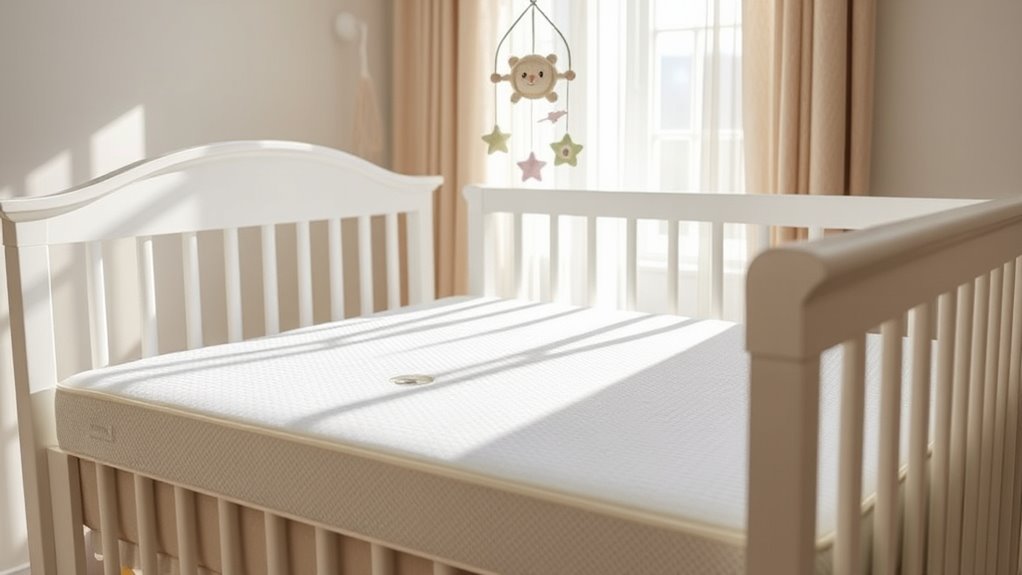
Breathability plays an essential role in sleep safety for infants, considerably lowering the risk of carbon dioxide buildup.
Choosing a breathable crib mattress can provide a safer crib environment for your little one, ensuring they sleep soundly and comfortably. Here are some key benefits:
- Enhanced airflow reduces overheating, promoting a comfy sleep setting.
- Breathe-through technology supports easy breathing, even if your baby sleeps face down.
- Pediatricians endorse firm, breathable mattresses for improved infant’s overall sleep safety.
With a breathable crib mattress, you can enjoy peace of mind knowing you’re taking steps to reduce the risk of SIDS and create a safer sleep space for your baby.
Prioritizing breathability in your crib mattress choice is a smart decision for your child’s well-being.
Chemical Safety and Material Considerations
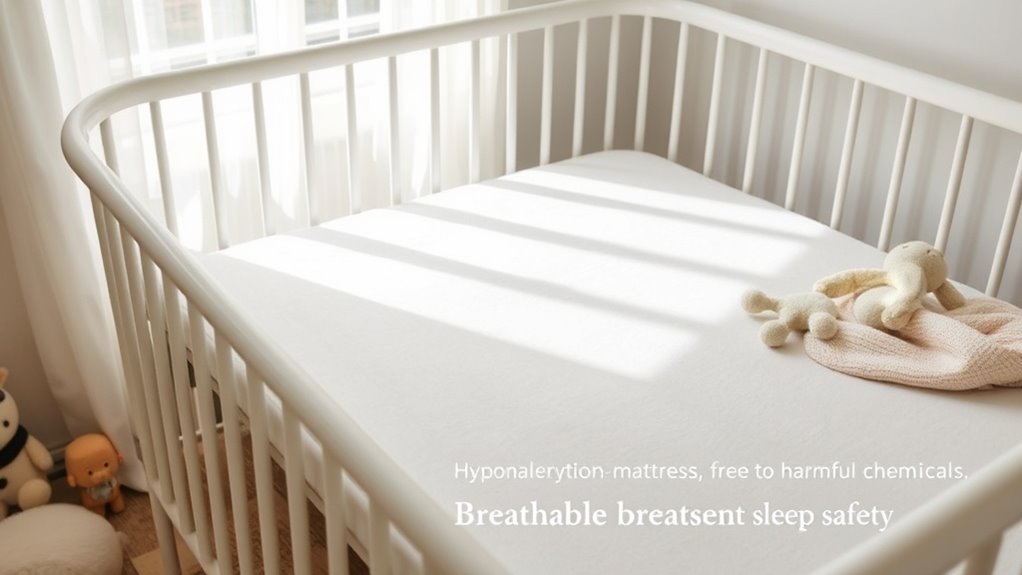
While ensuring your baby’s sleep environment is safe, it’s crucial to contemplate the materials used in crib mattresses. Many traditional options contain toxic chemicals like phthalates and volatile organic compounds (VOCs), which can harm your infant’s respiratory and nervous systems.
Recent legislation has aimed to ban harmful flame retardants, emphasizing the significance of chemical safety in sleep products. Choosing an organic crib mattress can notably reduce the risk of exposure to these harmful substances.
Look for EWG VERIFIED mattresses, as they guarantee low chemical emissions, ensuring a healthier sleep environment. Additionally, avoid materials like PVC or vinyl, which may release toxic compounds.
Prioritizing these factors will help create a safer and more supportive space for your little one.
Tips for Maintaining a Safe Sleep Environment
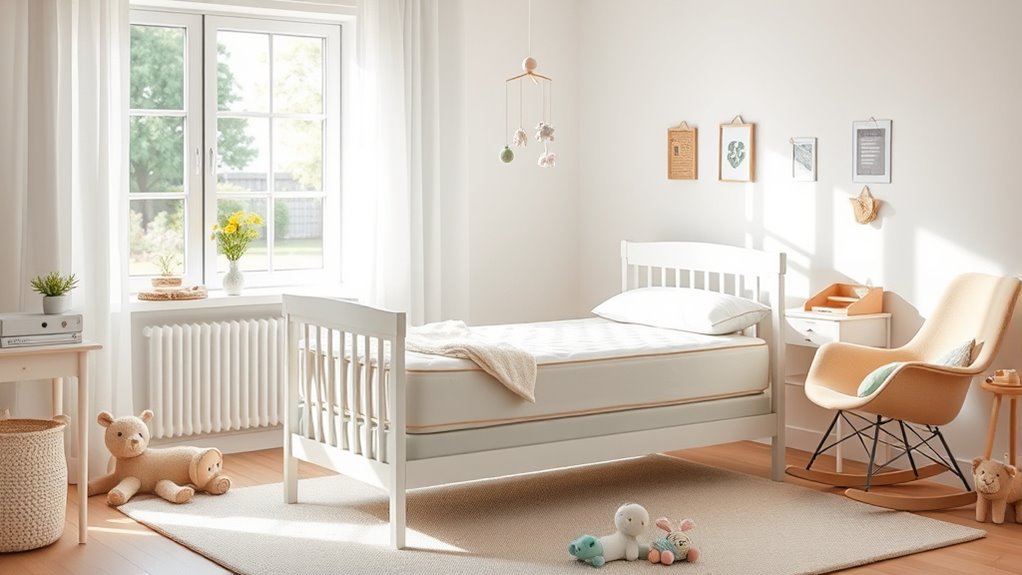
Creating a safe sleep environment for your baby is vital for their health and well-being. To reduce the risk of SIDS and guarantee a secure sleep area, follow these tips:
- Always place your baby on their back to sleep on a firm, flat crib mattress.
- Keep the sleep area free of soft objects and loose bedding to prevent suffocation hazards.
- Dress your baby in layers to manage their body temperature, checking for signs of overheating.
Using a crib, bassinet, or play yard that meets CPSC safety standards is important. Confirm the mattress fits snugly without gaps, and engage in supervised tummy time during awake hours to encourage development and enhance safety.
Prioritize these steps for your baby’s peaceful sleep.
Frequently Asked Questions
Are Crib Mattresses Safe for Babies?
When you’re considering crib mattresses for your baby, safety should be your top priority.
Make sure the mattress is firm and flat, as this minimizes risks like SIDS. Look for options that meet safety standards and are free from harmful chemicals.
Regularly clean the mattress to maintain a hypoallergenic environment.
Also, always place your baby on their back for sleep, ensuring a safe and comfortable rest for your little one.
What Is the Safest Type of Mattress for a Baby?
You might wonder what kind of mattress will keep your baby safe while they sleep. The safest choice is a firm, flat mattress that doesn’t have any indentations when your little one lies down.
Look for non-toxic materials, free from harmful chemicals, and check for certifications like GREENGUARD Gold. A snug fit in the crib prevents gaps, ensuring your baby stays secure.
Plus, easy cleaning helps create a hypoallergenic sleep space, promoting health and safety.
What Is the Safest Crib Mattress to Prevent SIDS?
To prevent SIDS, you’ll want a crib mattress that’s firm and meets CPSC safety standards.
Look for mattresses with breathe-through technology to guarantee airflow, reducing suffocation risk. Choosing GREENGUARD Gold Certified options minimizes exposure to harmful chemicals.
A washable cover is essential for maintaining cleanliness.
Also, consider room sharing; it can cut SIDS risk by up to 50%, so keep the crib close to where you sleep for added safety.
What Is the Safest Material for a Baby Mattress?
When you’re choosing a baby mattress, prioritize materials like organic cotton, natural latex, and food-grade polymers.
These options are free from harmful chemicals and VOCs, ensuring a safer sleep environment. Look for EWG VERIFIED mattresses, as they emit low chemicals and avoid toxic flame retardants.
Additionally, consider water-resistant covers made from non-toxic materials to protect against spills without compromising safety or breathability.
Your baby’s sleep comfort and health should always come first!
Conclusion
So, while you might think a soft, fluffy mattress is the ultimate sleep paradise for your little one, the reality is that firmness is key for safety. You wouldn’t want your baby to sink into a pillow-like cloud and disappear, right? By ensuring a snug fit, checking materials, and keeping breathability in mind, you’re not just following guidelines—you’re creating a safe haven. After all, a safe sleeper is a happy sleeper, and that means more peace for you!

